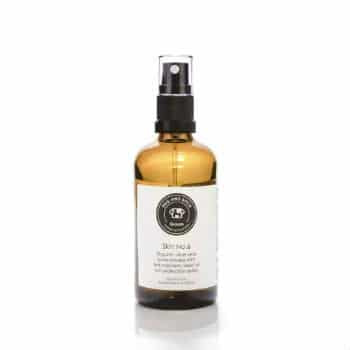Mosquitoes and fleas and ticks and sunburn — oh my! Warm weather may be great for spending more time outdoors with your dogs, but if you want the good times to last, be prepared to protect your pooch from the health hazards … they are everywhere.
This article has been updated.
For example, dogs with short hair, hairless breeds, or dogs with fair skin under their fur are more susceptible to sunburn, which can lead to skin cancer. But all dogs have vulnerable spots on the body when spending a day outside, including areas with less hair, like the belly and ears, as well as their nose.
Related: How to Create the Ultimate Backyard for Your Dog
Mosquitoes are everywhere, but especially around warm wet places, like swamps, bogs, or marshes and around ponds, rivers and lakes. Their bites are not only itchy, but they may also cause heartworm, a serious disease that can cause lung damage, heart failure, and even death.
Flea bites cause a variety of problems, from severe itching to tapeworm infections to anemia. And ticks carry diseases like Lyme disease, Canine Ehrlichiosis and even “tick paralysis.”
While there are plenty of sprays on the market to protect your dog from the hazards of being outdoors, some have chemicals that may make your dog sick.
Fortunately, there are natural alternatives that can be just as effective — and you can whip them up in your kitchen. But when you’re making your own insect repellent, remember that “natural” and “safe” aren’t equivalent. Also, while some essential oils are very effective canine insect repellents, they must be heavily diluted to prevent skin irritations, and some essential oils should never be used around dogs (or cats).
Here are some of the best DIY recipes for sprays that will protect your furry from biting insects and sunburn this summer.
Rose Geranium Tick Spray
This rose geranium tick spray recipe comes from the deep south, where they know about ticks! Their bites itch and burn, and they may carry serious diseases. It uses an essential oil that is safe for dogs when diluted, and it also makes them smell fabulous.
You’ll need a dark amber or blue glass spray bottle, but you can also use amber or blue HDPE (high density polyethylene) plastic bottles for taking on the road.
Ingredients:
- Rose geranium essential oil, therapeutic grade, 40 drops
- Witch hazel (without alcohol), 1 Tbsp
- Distilled water, 1/3 cup
Pour the witch hazel into the bottle first; use a stainless steel funnel if necessary. Add 40 drops of rose geranium essential oil. Then add in the distilled water. Put on cap, and shake to mix. Mist your dog from the head to the tail, neck, chest, and belly. Spray on your hands, then apply to face and ears (avoid the eyes and mouth). Reapply around every four hours, or when the scent disappears. Always reapply after swimming.
Related: How to Protect Your Dog From Fleas, Ticks and Mosquitoes This Summer
Lemon Eucalyptus Oil Mosquito Spray

SHOP NOW
Lemon eucalyptus oil has been found to be more effective as a mosquito repellant than DEET by Consumer Reports. However, it doesn’t last as long as DEET-based repellants.
For this recipe, use a glass spray bottle and a stainless-steel funnel if needed.
Ingredients:
- 15 drops lemon eucalyptus essential oil
- 2 ounces alcohol-free witch hazel (if your dog will be going in the water substitute almond oil or MCT oil)
Optional:
- 1 tsp real vanilla extract
- OR 6 drops peppermint essential oil
- OR 3 drops lavender essential oil or atlas cedarwood essential oil
Pour the witch hazel or oil in the spray bottle. Add 15 drops of lemon eucalyptus oil and one of the optional ingredients if desired. Shake well. Spray all over your dog from base of neck to tail, and under the neck, the chest, and belly. Spray on hands first to apply to face and ears. Be careful to avoid eyes. Reapply around every two hours.
Apple Cider Vinegar and Essential Oil Flea Spray
Fleas do not like apple cider vinegar or essential oils. That’s why this recipe for apple cider vinegar and essential oil flea spray can be effective at repelling fleas — and it’s much safer for your dog than chemical flea collars or commercial flea sprays and powders.
You’ll need a 16 ounce spray bottle.
Ingredients:
- 1 cup organic apple cider vinegar
- 3 drops non-toxic essential oil (lavender or peppermint)
- Water
Combine the apple cider vinegar with 3 drops of essential oil. Fill the rest of the bottle with water. Put on the cap and shake. Spray over entire body; put on hands first and then apply to face and ears. Reapply every 2 to 3 days. Avoid getting into eyes.
Related: Yes, Dogs Can Get Skin Cancer. Here’s What to Do About It.
Natural Sunscreen
If you have a hairless or short-haired dog, this natural sunscreen will help prevent sunburn. It’s also great for areas that have shaved due to surgery, or if your dog has a pink or light-colored nose. Never use sunscreen meant for humans on dogs.

SHOP NOW
You’ll need a glass bowl and a small, sterilized glass canning jar. To sterilize, take off lid and set aside. Place open, empty jar in a deep pot and cover with hot water to about one inch over open jar. Bring water to a rolling boil over high heat. Boil the jar for 10 to 16 minutes depending on your altitude. Remove jar with tongs, drain, and set on a clean surface to dry. You can sterilize the lid in the same water after it has cooled down a bit.
Ingredients:
- 1/2 cup organic aloe vera gel
- 5 1/2 tbsp organic coconut oil solid type
- 3/4 tsp vitamin E oil or 3 capsules
- 20 drops organic red raspberry seed oil
- 3 drops organic carrot oil
- 2 drops organic lavender oil
In the glass bowl, combine all ingredients, mixing thoroughly using a small spatula. Blending can take as long as eight to ten minutes depending on the temperature of the coconut oil. When it is completely blended, scoop out with spatula into the small glass canning jar. Seal tightly and store in refrigerator up to one month.
Use your hands to apply cream to your dog. Redirect attention if the dog tries to lick it off by using a high-value treat. Reapply cream every two to three hours.
Related: How to Prevent Your Dog’s Paws From Getting Burnt This Summer
This article is for informational purposes only. It is not, nor is it intended to be, a substitute for professional medical advice, diagnosis, or treatment and should never be relied upon for specific medical advice.
This article has been updated.


















